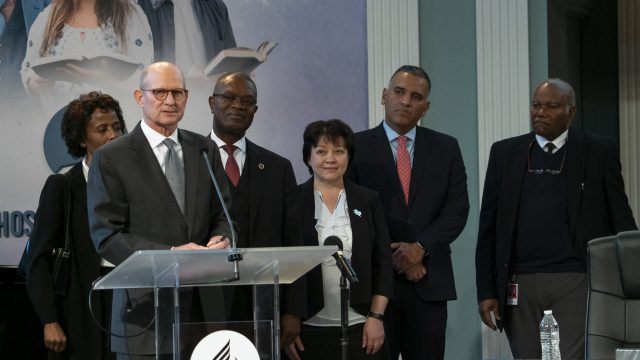As presented in Ellen White’s earlier writings

After the General Conference Session at Minneapolis in 1888, Ellen White was asked what she thought of the new light Ellet J. Waggoner and Alonzo T. Jones had presented. She responded, “Why, I have been presenting it to you for the last 45 years—the matchless charms of Christ. This is what I have been trying to present before your minds.”1 What did she mean by “the matchless charms of Christ,” and is there evidence that she presented them earlier in her ministry?
Emphasis in Her Early Ministry
Ellen White’s first use of the expression “matchless charms” in reference to Christ appears in a testimony in 1857. She wrote, “If Christ be in us the hope of glory, we shall discover such matchless charms in Him that the soul will be enamored. It will cleave to Him, choose to love Him, and in admiration of Him, self will be forgotten. Jesus will be magnified and adored, and self abased and humbled.”2 She used the similar expression “matchless depths of a Saviour’s love” several times throughout her early writings.
In 1852 she wrote about the happiness of children in the new earth: “They will look to the blessed Saviour who has given Himself for them, and, with admiration and love for Him who is smiling upon them, raise their voices and sing to His praise and glory, while they feel and realize the matchless depths of a Saviour’s love.”3 In another article she described Christ’s sacrifice for their salvation. “He died that you might live. O What a sacrifice was this! The tongue of an angel cannot tell the ‘matchless depths of a Saviour’s love.’ ”4 It is interesting that these early expressions were all addressed to young people.
Between 1858 and 1864 Ellen White wrote four volumes titled Spiritual Gifts, which contain the earliest version of the great controversy theme. While the expressions appear infrequently in these writings, when used they continue to highlight the Christocentric focus of her writings. For example, we find these words of amazement: “I lay down the pen, and exclaim, O what love! What wondrous love! The most exalted language cannot describe the glory of heaven, nor the matchless depths of a Saviour’s love.”5
One of the most impressive descriptions in all of Ellen White’s writings of the sufferings and atoning death of Christ was first published in 1869.6 No one who carefully reads this chapter could ever think that Ellen White’s focus on the cross of Christ came to the fore only in the latter part of her ministry. Note this passage: “The scenes of Calvary call for the deepest emotion. . . . The length, the breadth, the height, the depth, of such amazing love we cannot fathom. The contemplation of the matchless depths of a Saviour’s love should fill the mind, touch and melt the soul, refine and elevate the affections, and completely transform the whole character.”7
Continued Emphasis, 1869 to 1888
Because of the emphasis given to the 1888 General Conference Session, her Christocentric focus in the preceding decades has often been overlooked, even underrated. Consider these examples. From 1869: “We see beauty, and loveliness, and glory in Jesus. We behold in Him matchless charms.”8 In May 1870: “I recommend to you Jesus, my blessed Saviour. I adore Him; I magnify Him. Oh, that I had an immortal tongue, that I could praise Him as I desire! that I could stand before the assembled universe and speak in praise of His matchless charms!”9 In an earnest testimony to ministers: “They should keep before the mind the worth of souls, and the matchless depths of a Saviour’s love. This will awaken the soul so that with David they may say: ‘My heart was hot within me, while I was musing the fire burned.’ ”10
In 1876 Ellen White published a series of articles about her early life, Christian experience, and labors. In describing her opposers following the disappointment of 1844, she observed, “Those who had little interest for the salvation of souls . . . could not comprehend the love of God in my soul that quickened my desire to help those in darkness to the same light that cheered my path.” Then she made this significant remark: “Could they also have seen what had been revealed to me of God’s matchless love for men, manifested in giving His only Son to die for them, they would not have doubted my sincerity.”11
The death of Ellen White’s husband, James White, in August 1881 brought grief and loneliness, but it only intensified her desire to trust more fully in Christ and to uplift Him before fellow Christians and unbelievers. At the funeral she spoke about the resurrection, saying, “I look to that morning when the broken family links shall be re-united, and we shall see the King in His beauty, and behold His matchless charms, and cast our glittering crowns at His feet, and touch the golden harp and fill all Heaven with the strains of our music and songs to the Lamb. We will sing together there. We will triumph around the great white throne.”12
Ellen White spent two years in Europe, from 1885 to 1887. Her sermons contain frequent appeals to the matchless charms of Christ. A few examples will suffice. Preaching at Grimsby, England, she urged the importance of Bible study: “You should search the Bible, for it tells you of Jesus. I want you to read the Bible and see the matchless charms of Jesus. I want you to fall in love with the Man of Calvary, so that at every step you can say to the world, ‘His ways are ways of pleasantness, and all His paths are peace’ (see Proverbs 3:17).”13 About a month later, at Nimes, France, she raised the question, “Shall we not work for the Master?” Answering her own question, she urged, “We must put our best intellect to work for the Master. We must confess Christ to the world in His matchless charms.”14
Conclusion Ellen White’s writings were Christ-centered from beginning to end. She continually presented the matchless love of God manifested in Christ’s incarnation, ministry, suffering, atoning death, and the unspeakable gift of Christ’s righteousness for undeserving sinners. She exalted her Savior as the one altogether lovely, the Desire of all ages and all nations. For her it could all be summed up in the phrase “the matchless charms of Christ.” She was therefore fully justified when she said in 1889 that she had been presenting the matchless charms of Christ for the past 45 years. She continued to do so for another quarter century. And it was her desire, expressed in 1870, to do so for all eternity: “Oh, that I had an immortal tongue, that I could praise Him as I desire! That I could stand before the assembled universe and speak in praise of His matchless charms!”15
1 Ellen G. White, Sermons and Talks (Silver Spring, Md.: Ellen G. White Estate, 1990), vol. 1, pp. 116, 117.
2 Ellen G. White, Testimonies for the Church (Mountain View, Calif.: Pacific Press Pub. Assn., 1948), vol. 1, pp. 162, 163.
3 In The Youth’s Instructor, October 1852.
4 In Review and Herald, July 25, 1854.
5 Ellen G. White, Spiritual Gifts (Battle Creek, Mich.: Seventh-day Adventist Pub. Assn., 1858), vol. 1, pp. 210, 211.
6 Now found in Testimonies, vol. 2, pp. 200-215.
7 Ibid., p. 213.
8 In Review and Herald, Apr. 19, 1870. Toward the end of those remarks Ellen White called upon her hearers not to dwell upon their troubles and perplexities, but rather upon “the matchless charms of the loving Saviour, and His undying love for sinners” (ibid.).
9 In Review and Herald, May 31, 1870; also in Testimonies, vol. 2, p. 593.
10 Testimonies, vol. 2, p. 504.
11 In Signs of the Times, May 11, 1876.
12 Ellen G. White, In Memoriam: A Sketch of the Last Sickness and Death of Elder James White (Battle Creek, Mich.: Review and Herald Press, 1881), p. 43.
13 Ellen G. White manuscript 80, 1886, in Ellen G. White, Manuscript Releases (Silver Spring, Md.: Ellen G. White Estate, 1990), vol. 9, pp. 250, 251, retrieved from https://egwwritings.org/book/b14054.
14 Ellen G. White manuscript 39, 1886, in E. G. White, Manuscript Releases, vol. 3, p. 70, retrieved from https://egwwritings.org/book/b14054.
15 Testimonies, vol. 2, p. 593.








